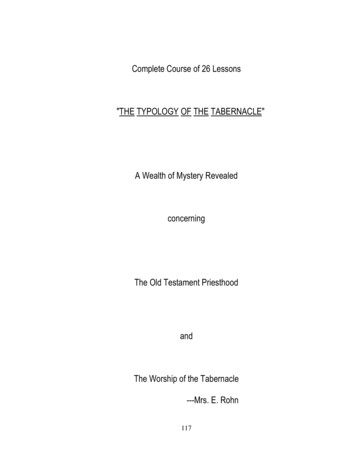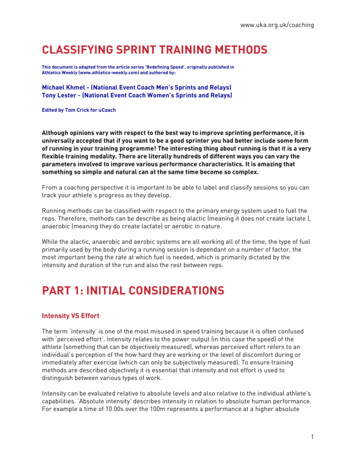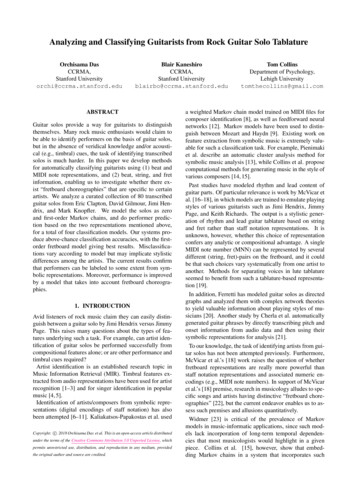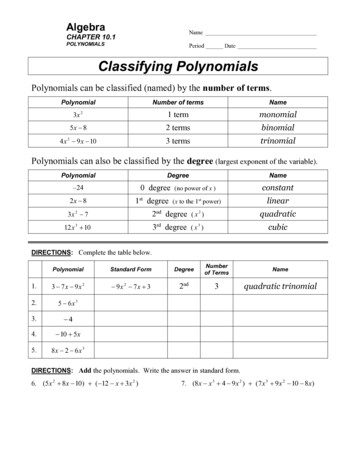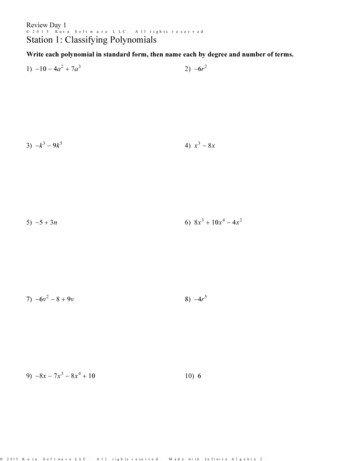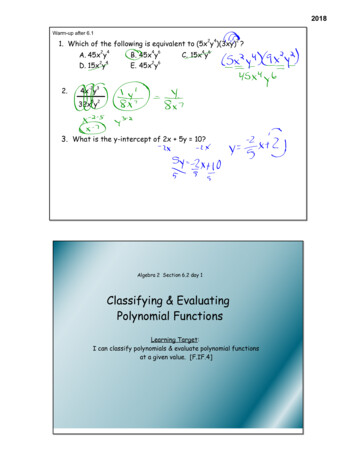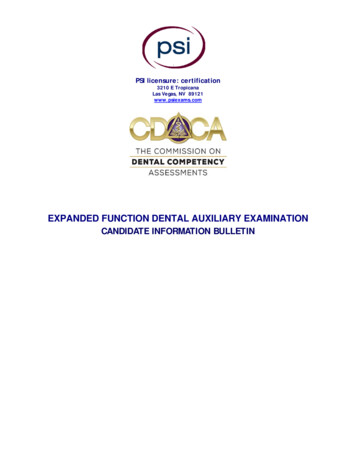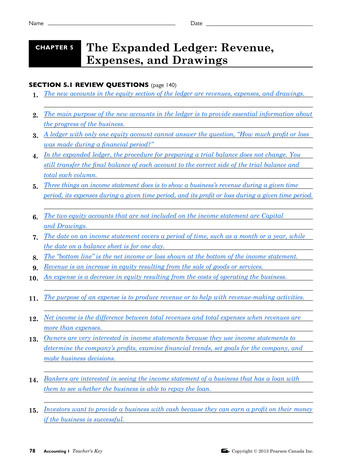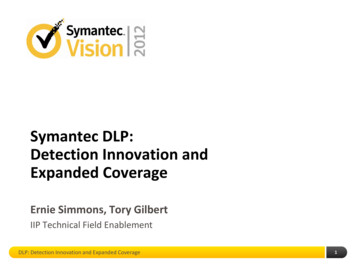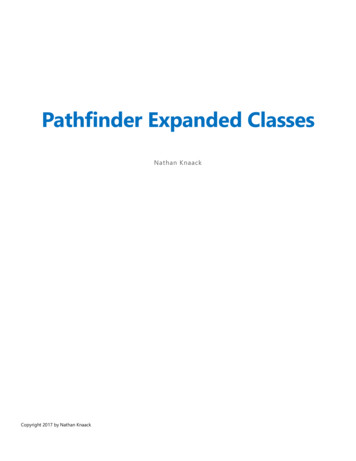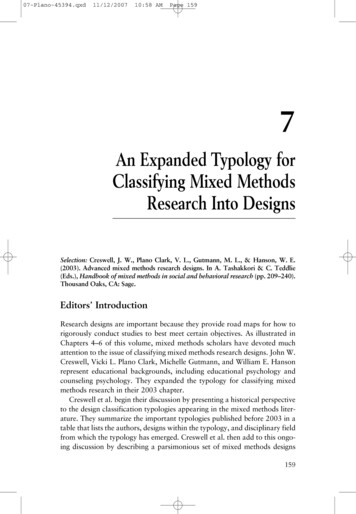
Transcription
07-Plano-45394.qxd11/12/200710:58 AMPage 1597An Expanded Typology forClassifying Mixed MethodsResearch Into DesignsSelection: Creswell, J. W., Plano Clark, V. L., Gutmann, M. L., & Hanson, W. E.(2003). Advanced mixed methods research designs. In A. Tashakkori & C. Teddlie(Eds.), Handbook of mixed methods in social and behavioral research (pp. 209–240).Thousand Oaks, CA: Sage.Editors’ IntroductionResearch designs are important because they provide road maps for how torigorously conduct studies to best meet certain objectives. As illustrated inChapters 4–6 of this volume, mixed methods scholars have devoted muchattention to the issue of classifying mixed methods research designs. John W.Creswell, Vicki L. Plano Clark, Michelle Gutmann, and William E. Hansonrepresent educational backgrounds, including educational psychology andcounseling psychology. They expanded the typology for classifying mixedmethods research in their 2003 chapter.Creswell et al. begin their discussion by presenting a historical perspectiveto the design classification typologies appearing in the mixed methods literature. They summarize the important typologies published before 2003 in atable that lists the authors, designs within the typology, and disciplinary fieldfrom which the typology has emerged. Creswell et al. then add to this ongoing discussion by describing a parsimonious set of mixed methods designs159
07-Plano-45394.qxd11/12/200710:58 AMPage 160160——The Mixed Methods Readerthat builds from these earlier works. They distill four criteria that areimplicit within all mixed methods designs, including the phase of research inwhich “mixing” occurs (integration) and the use of a theoretical lens (forexample, feminist research). These additional criteria make explicit newdesign characteristics that had not been emphasized in other discussions.They then present a set of six major designs found in the mixed methods literature using these criteria. Finally, the authors discuss the relationship ofparadigms to designs and suggest that different paradigms may provide thefoundation for different mixed methods designs.Discussion Questions and Applications1. Consider a mixed methods study such as reported by Victor, Ross, andAxford (Chapter 18 in this volume) or Milton, Watkins, Studdard, andBurch (Chapter 22 in this volume). Determine how Creswell et al.’sdesign criteria were implemented and the study’s overall design.2. How would you identify if a mixed methods study used a theoreticalperspective?3. Compare and contrast Creswell et al.’s typology with those presentedin Chapters 5 and 6. What advantages and/or disadvantages do youfind with each?Related References That Extend the TopicOther recent mixed methods design typologies can be found in:Creswell, J. W., & Plano Clark, V. L. (2007). Designing and conducting mixedmethods research. Thousand Oaks, CA: Sage.Tashakkori, A., & Teddlie, C. (2003). The past and future of mixed methodsresearch: From data triangulation to mixed model designs. In A. Tashakkori& C. Teddlie (Eds.), Handbook of mixed methods in social and behavioralresearch (pp. 671–701). Thousand Oaks, CA: Sage.
07-Plano-45394.qxd11/12/200710:58 AMPage 161Advanced Mixed MethodsResearch DesignsJohn W. CreswellUniversity of Nebraska–LincolnVicki L. Plano ClarkUniversity of Nebraska–LincolnMichelle L. GutmannUniversity of Nebraska–LincolnWilliam E. HansonUniversity of Nebraska–LincolnOne approach to learning about mixed methods research designs is tobegin with a mixed methods study and explore the features that characterize it as mixed methods research. Although many such studies are available in the literature, we begin here with a study in education exploring thefactors associated with parental savings for postsecondary education, a topicto which many people can relate. Hossler and Vesper (1993) conducted astudy examining the factors associated with parental savings for childrenattending higher education campuses. Using longitudinal data collected fromstudents and parents over a 3-year period, the authors examined factorsmost strongly associated with parental savings for postsecondary education.Their results indicated that parental support, educational expectations, andSOURCE: This chapter is reprinted from Handbook of Mixed Methods in Social and BehavioralResearch (Tashakkori & Teddlie, 2003). Reprinted with permission of Sage Publications, Inc.161
07-Plano-45394.qxd11/12/200710:58 AMPage 162162——The Mixed Methods Readerknowledge of college costs were important factors. Most important for ourpurposes, the authors collected information from parents and students on182 surveys and from 56 interviews.To examine this study from a mixed methods perspective, we would liketo draw attention to the following: The authors collected “mixed” forms of data, including quantitative surveydata and qualitative open-ended interview data. The authors titled the study “An Exploratory Study of the Factors AssociatedWith Parental Savings for Postsecondary Education,” containing words suggestive of both quantitative and qualitative approaches. The word exploratoryis often associated with qualitative research, while the word factors implies theuse of variables in quantitative research. The authors advanced a purpose statement that included a rationale for mixing methods: “The interviews permitted us to look for emerging themes fromboth the survey and from previous interview data, which could then beexplored in more depth in subsequent interviews” (p. 146). The authors reported two separate data analyses: first the quantitative resultsof the survey, followed by the findings from the qualitative interviews. Anexamination of these two sections shows that the quantitative analysis is discussed more extensively than the qualitative analysis. The authors ended the article with a discussion that compared the quantitativestatistical results with the qualitative thematic findings.Based on these features, we see the authors mixing quantitative and qualitative research in this study—mixed methods research. More specifically,with information from recent literature on mixed methods research designs,the “type” of mixed methods design used by Hossler and Vesper (1993) intheir study might be called a “concurrent triangulation method design,”indicating a triangulation of data collection, separate data analysis, and theintegration of databases at the interpretation or discussion stage of the report.Furthermore, their design gave priority to quantitative research.To give their study a mixed methods name and to identify the characteristics of the design may not have affected whether it was accepted for publication or whether it was given enhanced status in the social science community.However, being able to identify the characteristics of the study that make itmixed methods and giving the design a specific name conveys to readers therigors of their study. It also provides guidance to others who merge quantitative and qualitative data into a single study. If they were presenting it tojournal editors, faculty committees, or funding agencies, the labeling of thedesign and an identification of its characteristics helps reviewers to decide the
07-Plano-45394.qxd11/12/200710:58 AMPage 163An Expanded Typology for Mixed Methods——163criteria and the personnel most qualified to review the study. If Hossler andVesper (1993) had created a visual representation or figure of their procedures,it would have enhanced the study’s readability to audiences not used to seeingcomplex and interrelated data collection and analysis procedures.Like many other studies of its kind, the Hossler and Vesper (1993) studyfalls into a category of research called mixed methods designs. Althoughthese studies are frequently reported in the literature, they are seldom discussed as a separate research design. However, with an increasing numberof authors writing about mixed methods research as a separate design, it isnow time to seriously consider it as a distinct design in the social sciences.To do this calls for a review of disparate literature about mixed methodsresearch designs found in journals across the social sciences as well as inchapters, books, and conference papers.This chapter presents a synthesis of recent literature about mixed methodsresearch as a separate design. It creates an analysis of the discussion today andits historical roots over the past 20 years. It then reviews four criteria that haveemerged during the past few years that provide guidance for a researcher trying to identify the type of mixed methods design to use in a particular study.From these criteria emerge six core designs under which many types of designcurrently being discussed can be subsumed. We then review three issues inimplementing the designs: the use of paradigm perspectives, the data analysisprocedures used with each design, and the use of expanded visualizations andprocedures. We end by returning to the Hossler and Vesper (1993) study toreview how it might be presented and understood as a mixed methods design.Mixed Methods Research as a Separate DesignThere are a number of arguments for why mixed methods research mightbe considered a separate research design in the social sciences. By design, wemean a procedure for collecting, analyzing, and reporting research such asthat found in the time-honored designs of quantitative experiments andsurveys and in the qualitative approaches of ethnographies, grounded theorystudies, and case studies. These arguments take several forms. Authors haveincreasingly recognized the advantages of mixing both quantitative andqualitative data collection in a single study. Numerous mixed methods studies have been reported in the scholarly journals for social scientists to see anduse as models for their own studies. In addition, authors have delineatedmore carefully a definition for mixed methods research, although consensushas been slow to develop for a single definition recognized by all inquirers.
07-Plano-45394.qxd11/12/200710:58 AMPage 164164——The Mixed Methods ReaderFinally, method and methodological authors who write about mixed methods research have identified procedures that point toward critical designelements such as a visual model of procedures, a notation system, the explication of types of designs, and specific criteria useful in deciding what typeof design to employ in a given study.A Recognition of AdvantagesThe collection and combination of both quantitative and qualitative datain research has been influenced by several factors. Unquestionably, bothquantitative and qualitative data are increasingly available for use in studying social science research problems. Also, because all methods of data collection have limitations, the use of multiple methods can neutralize or cancelout some of the disadvantages of certain methods (e.g., the detail of qualitative data can provide insights not available through general quantitative surveys) (Jick, 1979). Thus, there is wide consensus that mixing different typesof methods can strengthen a study (Greene & Caracelli, 1997). Qualitativeresearch has become an accepted legitimate form of inquiry in the socialsciences, and researchers of all methodological persuasions recognize itsvalue in obtaining detailed contextualized information. Also, because socialphenomena are so complex, different kinds of methods are needed to bestunderstand these complexities (Greene & Caracelli, 1997).Published Mixed Methods StudiesGiven these advantages, authors writing about mixed methods researchhave frequently analyzed published mixed methods studies in terms of theirprocedures. For example, Greene, Caracelli, and Graham (1989) reviewed 57evaluation studies so as to develop a classification scheme of types of designsbased on purpose and design characteristics. Creswell, Goodchild, and Turner(1996) discussed 19 mixed methods studies about postsecondary educationand illustrated steps in the studies. The “box feature” was used extensively inTashakkori and Teddlie’s (1998) book to illustrate examples of mixed methods research projects. In fact, a review of the many procedural discussionsabout mixed methods research [see Datta’s (1994) review of 18 methodological discussions about mixed methods research from 1959 to 1992] shows references to published studies across the social science disciplines.The Issue of DefinitionFinding these published studies, however, requires some creative searching of the literature. The actual terms used to denote a mixed methods study
07-Plano-45394.qxd11/12/200710:58 AMPage 165An Expanded Typology for Mixed Methods——165vary considerably in the procedural discussions of this design. Writers havereferred to it as multitrait-multimethod research (Campbell & Fiske, 1959),integrating qualitative and quantitative approaches (Glik, Parker, Muligande,& Hategikamana, 1986–1987; Steckler, McLeroy, Goodman, Bird, & McCormick,1992), interrelating qualitative and quantitative data (Fielding & Fielding,1986), methodological triangulation (Morse, 1991), multimethodologicalresearch (Hugentobler, Israel, & Schurman, 1992), multimethod designs andlinking qualitative and quantitative data (Miles & Huberman, 1994), combining qualitative and quantitative research (Bryman, 1988; Creswell, 1994;Swanson-Kauffman, 1986), mixed model studies (Datta, 1994), and mixedmethods research (Caracelli & Greene, 1993; Greene et al., 1989; Rossman& Wilson, 1991). Central to all of these terms is the idea of combining orintegrating different methods. The term mixed methods is perhaps mostappropriate, although one; of the authors of this chapter has used others(Creswell, 1994; Creswell et al., 1996; Creswell & Miller, 1997). Mixingprovides an umbrella term to cover the multifaceted procedures of combining, integrating, linking, and employing multi-methods.To argue for mixed methods research as a specific research designrequires not only an accepted term but also a common definition. Buildingon earlier definitions of mixed methods research (Fielding & Fielding, 1986;Greene et al., 1989), a mixed methods research design at its simplest levelinvolves mixing both qualitative and quantitative methods of data collectionand analysis in a single study (Creswell, 1999). A more elaborate definitionwould specify the nature of data collection (e.g., whether data are gatheredconcurrently or sequentially), the priority each form of data receives in theresearch report (e.g., equal or unequal), and the place in the research processin which “mixing” of the data occurs such as in the data collection, analysis, or interpretation phase of inquiry. Combining all of these features into asingle definition suggests the following definition:A mixed methods study involves the collection or analysis of both quantitativeand/or qualitative data in a single study in which the data are collected concurrently or sequentially, are given a priority, and involve the integration of thedata at one or more stages in the process of research.This definition, although a reasonable beginning point for consideringmixed methods research designs, masks several additional questions that aredeveloped further in this chapter. For example, this definition does notaccount for multiple studies within a sustained program of inquiry in whichresearchers may mix methods at different phases of the research. It also creates an artificial distinction between quantitative and qualitative methodsof data collection that may not be as firmly in place as people think (see
07-Plano-45394.qxd11/12/200710:58 AMPage 166166——The Mixed Methods ReaderJohnson and Turner’s detailed discussion about types of data in Chapter 11of this volume [Tashakkori & Teddlie, 2003]). Furthermore, it does notaccount for a theoretical framework that may drive the research and createa larger vision in which the study may be posed.The Trend Toward Procedural GuidelinesThe history of mixed methods research has been adequately traced elsewhere (see Creswell, 2002; Datta, 1994; Tashakkori & Teddlie, 1998).Central to this discussion is the development of procedural guidelines thatargue for viewing mixed methods research as a separate design. The evolutionof procedural guidelines for mixed methods studies is seen in the creation ofvisual models, a notation system, and the specification of types of designs.Visual Models. Procedures for conducting a mixed methods study firstemerged from discussions in which authors described the flow of activitiestypically used by researchers when they conducted this type of study. Forexample, Sieber (1973) suggested the combination of in-depth case studieswith surveys, creating a “new style of research” and the “integration” ofresearch techniques within a single study (p. 1337). Patton (1990) identifiedseveral forms of research as “mixed forms” such as experimental designs,qualitative data and content analysis or experimental designs, qualitativedata, and statistical data. Soon, writers began to draw procedures graphically and create figures that displayed the overall flow of research activities.A good example of these visuals is found in health education research. Asshown in Figure 7.1, Steckler et al. (1992) provided four alternative procedures for collecting both quantitative and qualitative research and gave abrief rationale for the reason for combining methods. These models showboth quantitative and qualitative methods (actually data collection) and usearrows to indicate the sequence of activities in the mixed methods study.Models 2 and 3 are similar except that the procedures begin with qualitativedata in Model 2 and with quantitative data in Model 3.Notation System. Models such as these provide a useful way for readers tounderstand the basic procedures used in mixed methods studies. Implied inthese models is also the idea that a notation system exists to explain the procedures. In 1991, Morse, a nursing researcher, developed a notation systemthat has become widely used by researchers designing mixed methods studies(see also Morse’s notation system as she discusses types of designs in Chapter 7of this volume [Tashakkori & Teddlie, 2003]). As shown in Figure 7.2,Morse discussed several types of mixed methods studies and illustrated themwith a plus ( ) sign to denote the simultaneous collection of quantitative and
07-Plano-45394.qxd11/12/200710:58 AMPage 167An Expanded Typology for Mixed Methods——167Model 1. Qualitative methods are used to help develop quantitativemeasures and instruments.QUALITATIVEQUANTITATIVERESULTSModel 2. Quantitative methods are used to embellish a primarilyqualitative study.QUALITATIVERESULTSQUANTITATIVEModel 3. Qualitative methods are used to help explain quantitative findings.QUANTITATIVERESULTSQUALITATIVEModel 4. Qualitative and quantitative methods are used equally and in parallel.QUALITATIVEFigure 7.1RESULTSQUANTITATIVEExample of Visual Presentation of ProceduresSOURCE: Steckler, McLeroy, Goodman, Bird, and McCormick (1992).qualitative data, an arrow ( ) to designate that one form of data collectionfollowed another, uppercase letters to suggest major emphasis (e.g., QUAN,QUAL) on the form of data collection, and lowercase letters to imply lessemphasis (e.g., quan, qual). It is also noteworthy that the terms quantitativeand qualitative were now shortened to quan and qual, respectively, implyingthat both approaches to research are legitimate and of equal stature.Types of Designs. As is apparent in Morse’s (1991) notation system, she provided names for her approaches such as simultaneous and sequential. Termssuch as these, and a few more, have now become types or variants of mixed
07-Plano-45394.qxd11/12/200710:58 AMPage 168168——The Mixed Methods ReaderFigure 7.2ApproachTypeQUAL quanSimultaneousQUAL quanSequentialQUAN qualSimultaneousQUAN qualSequentialExamples of Types of Designs Using Morse’s (1991) NotationSystemmethods designs. As shown in Table 7.1, authors from diverse disciplinefields, such as evaluation, nursing, public health, and education, have identified the types of designs that they believe capture the array of possibilities. Abrief review of eight studies shown in the table indicates that Morse’s simultaneous and sequential labels continue to be used routinely. However, newterms have also emerged such as a mixed methods study that is based oninitiation or development (Greene et al., 1989), on complementary designs(Morgan, 1998), or on mixed model designs (Tashakkori & Teddlie, 1998).Unquestionably, authors have yet to reach consensus on the types of designsthat exist, the names for them, or how they might be represented visually.Criteria Implicit in the DesignsAlthough the variants of designs may be baffling, to distinguish among themis useful in choosing one to use for a study. To accomplish this requiresexamining the design’s fundamental assumptions, a line of thinking alreadyused by Morgan (1998). If one could understand the assumptions implicitwithin the designs, then a researcher could configure a procedure that bestmeets the needs of the problem and that includes the collection of both quantitative and qualitative data. Morgan identified two core assumptions: thatthe designs varied in terms of a sequence of collecting quantitative and qualitative data and that they varied in terms of the priority or weight given toeach form of data. Other assumptions can be added as well. Tashakkori andTeddlie (1998) suggested that the design contain an integration of the datain different phases such as in the statement of the research questions, thedata collection, the data analysis, and the interpretation of the results. Finally,in the recent writings of Greene and Caracelli (1997), we find that somemixed methods writers include a transformational value- or action-orienteddimension to their study. Thus, we have another assumption that needs to
07-Plano-45394.qxd11/12/200710:58 AMPage 169An Expanded Typology for Mixed Methods——169Table 7.1Classifications of Mixed Methods DesignsAuthorMixed Methods DesignsDiscipline/FieldGreene,Caracelli, &Graham riangulationEvaluationPatton (1990)Experimental design, qualitativedata, and content analysisExperimental design, qualitativedata, and statistical analysisNaturalistic inquiry, qualitativedata, and statistical analysisNaturalistic inquiry, quantitativedata, and statistical analysisEvaluationMorse (1991)Simultaneous triangulationQUAL quanQUAN qualSequential triangulationQUAL quanQUAN qualNursingSteckler,McLeroy,Goodman, Bird,& McCormick(1992)Model 1: qualitative methodsto develop quantitative measuresModel 2: quantitative methodsto embellish qualitative findingsModel 3: qualitative methods toexplain quantitative findingsModel 4: qualitative and quantitativemethods used equally and parallelPublic healtheducationGreene &Caracelli (1997)Component ed designsIterativeEmbedded or nestedHolisticTransformativeEvaluationMorgan (1998)Complementary designsQualitative preliminaryQuantitative preliminaryQualitative follow-upQuantitative follow-upHealth research(Continued)
07-Plano-45394.qxd11/12/200710:58 AMPage 170170——The Mixed Methods ReaderTable 7.1 (Continued)AuthorMixed Methods DesignsDiscipline/FieldTashakkori &Teddlie (1998)Mixed method designsEquivalent status (sequential orparallel)Dominant-less dominant (sequentialor parallel)Multilevel useMixed model designsI: Confirmatory/QualData/Statistical analysis andinferenceII: Confirmatory/QualData/Qualitative inferencesIII: Exploratory/QuantData/Statistical analysis andinferenceIV: Exploratory/QualData/Statistical analysis andinferenceV: Confirmatory/QuantData/Qualitative inferencesVI: Exploratory/QuantData/Qualitative inferencesVII: Parallel mixed modelVIII: Sequential mixed modelEducational researchCreswell (1999)Convergence modelSequential modelInstrument-building modelEducational Policybe included in the matrix for typing and identifying forms of mixed methodsdesigns. Four factors, as illustrated in Figure 7.3, help researchers to determine the type of mixed methods design for their study: the implementationof data collection, the priority given to quantitative or qualitative research,the stage in the research process at which integration of quantitative andqualitative research occurs, and the potential use of a transformational valueor action-oriented perspective in their study.Implementation of Data CollectionImplementation refers to the sequence the researcher uses to collect bothquantitative and qualitative data. Several authors have discussed this procedure
07-Plano-45394.qxd11/12/200710:58 AMPage 171An Expanded Typology for Mixed Methods——171ImplementationNo rspectiveAt Data CollectionEqualExplicitAt Data AnalysisSequential—Qualitative firstQualitativeAt DataInterpretationSequential—Quantitative firstFigure 7.3ImplicitQuantitativeWith SomeCombinationDecision Matrix for Determining a Mixed Methods Designin mixed methods research (Greene et al., 1989; Morgan, 1998; Morse,1991). The options for implementation of the data collection consist of gathering the information at the same time (i.e., concurrently) or introducing theinformation in phases over a period of time (i.e., sequentially). When thedata are introduced in phases, either the qualitative or the quantitativeapproach may be gathered first, but the sequence relates to the objectivesbeing sought by the researcher in the mixed methods study. When qualitative data collection precedes quantitative data collection, the intent is to firstexplore the problem under study and then follow up on this explorationwith quantitative data that are amenable to studying a large sample so thatresults might be inferred to a population. Alternatively, when quantitativedata precede qualitative data, the intent is to explore with a large sample firstto test variables and then to explore in more depth with a few cases duringthe qualitative phase. In concurrently gathering both forms of data at the
07-Plano-45394.qxd11/12/200710:58 AMPage 172172——The Mixed Methods Readersame time, the researcher seeks to compare both forms of data to search forcongruent findings (e.g., how the themes identified in the qualitative datacollection compare with the statistical results in the quantitative analysis).The choice of implementation strategy has several consequences for theform of the final written report. When two phases of data collection exist,the researcher typically reports the data collection process in two phases.The report may also include an analysis of each phase of data separately andthe integration of information in the discussion or conclusion section ofa study. The implementation approach also raises an issue about iterativephases of a design where a researcher may cycle back and forth betweenquantitative and qualitative data collection. For instance, the research maybegin with a qualitative phase of interviewing, followed by a quantitativephase of survey instrument design and testing with a sample, and continuedon with a third qualitative phase of exploring outlier cases that emerge fromthe quantitative survey. The implementation decision also calls for clearlyidentifying the core reasons for collecting both forms of data in the first placeand understanding the important interrelationship between the quantitativeand qualitative phases in data collection. These reasons need to be clearlyarticulated in any mixed methods written report.PriorityA less obvious issue, and one more difficult to make a decision about, is thepriority given to quantitative and qualitative research in the mixed methodsstudy (Morgan, 1998). Unlike the frame of reference of data collection in theimplementation decision, here the focus is on the priority given to quantitativeor qualitative research as it occurs throughout the data collection process. Thisprocess might be described as including how the study is introduced, the useof literature, the statement of the purpose of the study and the research questions, the data collection, the data analysis, and the interpretation of the findings or results (Creswell, 2002). The mixed methods researcher can give equalpriority to both quantitative and qualitative research, emphasize qualitativemore, or emphasize quantitative more. This emphasis may result from practical constraints of data collection, the need to understand one form of databefore proceeding to the next, or the audience preference for either quantitative or qualitative research. In most cases, the decision probably rests on thecomfort level of the researcher with one approach as opposed to the other.Operationalizing the decision to give equal or unequal emphasis to quantitative or qualitative research translates is problematic. For instance, the studymay begin with essentially a quantitative orientation with a focus on variables, specific research questions or hypotheses, and an extensive discussionof the literature that informs the questions. Another study might convey a
07-Plano-45394.qxd11/12/200710:58 AMPage 173An Expanded Typology for Mixed Methods——173different priority through the length of discussions such as the inclusion ofextensive discussions about the qualitative data collection with minimal information about the quantitative instruments used in the study. A project mightbe seen by readers as providing more depth for one method than for the othersuch as assessed by the number of pages given to quantitative research (e.g.,as in the Hossler & Vesper [1993] article). A graduate student may of necessity delimit the study by including a substantive quantitative analysis and alimited qualitative data collection, a model referred to as the dominant-lessdominant model (Creswell, 1994). A final example is that the published article provides equal emphasis on both quantitati
07-Plano-45394.qxd 11/12/2007 10:58 AM Page 159. that builds from these earlier works. They distill four criteria that are implicit within all mixed methods designs, including the phase of research in . There are a number
